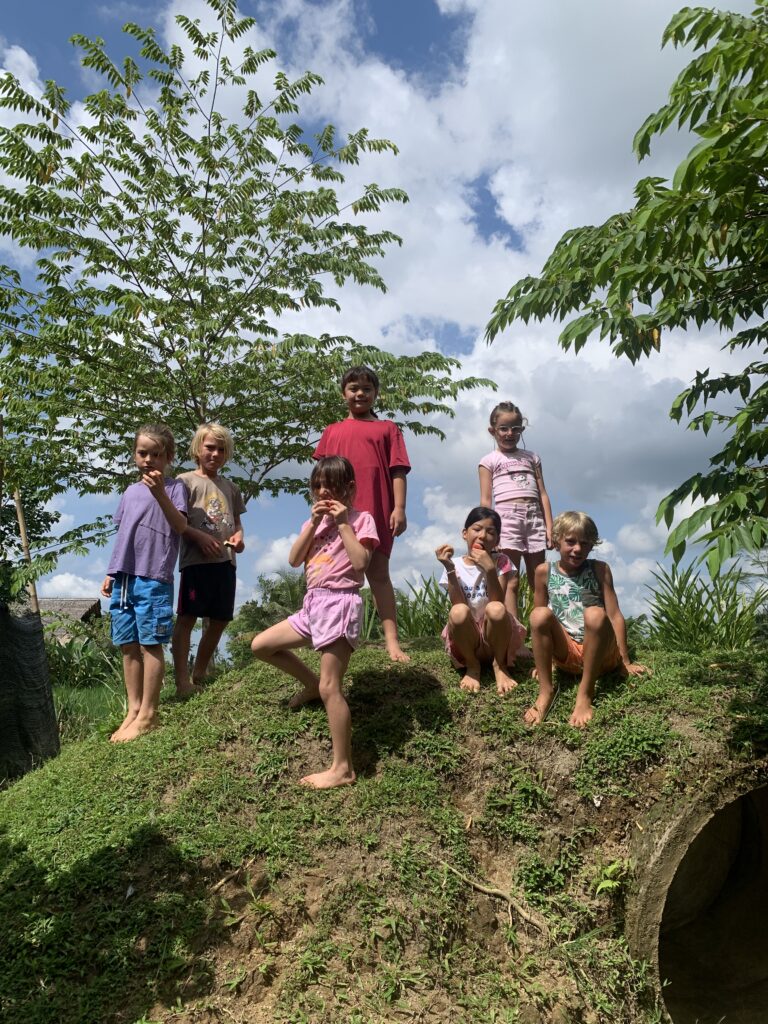At Empathy School in Ubud, Bali, the lush green surroundings are more than just a backdrop; they are an integral part of the curriculum designed to foster imagination and creativity among its students. The belief that nature can significantly amplify creativity is palpable in every corner of the school’s expansive green playgrounds.
In these verdant playgrounds, the natural world becomes a canvas for the children’s imagination. Logs transform into pirate ships, bushes become hidden caves for treasure, and stones turn into ancient artifacts. This setting not only encourages physical activity but also promotes imaginative play, which is critical in developing creative thinking and expanding vocabulary.
As children navigate through these imaginative scenarios, they are compelled to articulate complex ideas and narratives. This form of play naturally enriches their vocabulary, as they must find words to describe their elaborate games and the elements involved in them.
Ella and Liam, two-spirited third-graders, are crouched behind a large frangipani tree, their eyes wide with excitement.
“Look! The lava is almost touching our base! We need to build a bridge to escape to the Crystal Cave!” Said Ella.
Liam, looking around and spotting a series of small rocks leading to a hollow log, exclaims, “There! Those stones are stepping stones. Let’s jump across them to get to the cave!”
As they move, Ella picks up a long, twisted stick. “This is the magic wand of wind. I’ll use it to blow the lava away from our path!” Added Ella.
Liam replied, “Great idea! And I’ll gather these leaves to make a shield to protect us from dragon fire.”
The language used here is rich with imaginative concepts, prompted by the natural elements around them. Ella and Liam are not just playing; they are creators of their own universe, where each item in their environment serves a purpose in their story.
Teachers at Empathy School play a pivotal role in facilitating this imaginative play. They are trained to observe and interact subtly, providing just enough guidance to enhance the play without taking over the children’s creative lead. They introduce new vocabulary during these interactions subtly, describing parts of the environment or suggesting ideas that expand the children’s ongoing narratives.
For example, a teacher once said, “I see you’ve found the Wand of Wind! What powers does it possess? Perhaps it can summon creatures of the air as well?”
This suggestion might lead the children to introduce new elements into their play, each requiring further explanation and discussion, thereby enriching their vocabulary and narrative skills even further.
Through such dynamic and imaginative interactions, children at Empathy School not only expand their vocabulary but also develop crucial cognitive abilities like problem-solving and abstract thinking. The creativity fostered in these green playgrounds prepares them to think outside the box, a skill that will benefit them across all areas of study and stages of life.
The natural setting of Empathy School thus serves as both a playground and a powerful educational tool, proving that when children’s environments are as open and varied as their imaginations, their potential for learning and growth knows no bounds.
While the benefits of green, nature-filled playgrounds are increasingly recognized, it’s important to consider the limitations presented by more structured, non-natural play environments. These settings, often characterized by their rigid layouts and synthetic materials, may not provide the same opportunities for imaginative play and language development.
Recent research highlights how structured, non-natural play environments can restrict the ways in which children use language and engage creatively. A study conducted by the University of Minnesota examined the differences in language use between children playing in natural versus structured playgrounds. The findings indicated that children in structured playgrounds used less descriptive language and engaged in more repetitive and functional communication. The study suggests that the predictable and less stimulating nature of these environments may limit children’s opportunities to explore new vocabulary and complex narratives.
In structured playgrounds, the play equipment often dictates the nature of the play. For example, a slide is used for sliding down, and a swing is used for swinging. This limits the scenarios that children can invent and the roles they can assume. Without natural elements to manipulate or varied terrains to navigate, the scope for imaginative play is considerably narrowed.
Moreover, the sensory experiences in these environments are often less diverse. The tactile feeling of synthetic surfaces, the uniformity of manufactured play structures, and the absence of natural sounds and smells can make these settings less engaging. This sensory monotony can lead to a form of sensory under-stimulation, where children are not encouraged to explore and describe their environment in new and complex ways.
The lack of sensory stimuli and creative freedom in structured playgrounds directly impacts language development. Without the need to describe varied experiences or negotiate complex scenarios, children may not develop the same range of descriptive and narrative skills that they would in a more stimulating environment. Language development thrives on novelty, challenges, and social interaction—all of which are more abundant in natural, unstructured settings.
This body of research is supported by educational theories that emphasize the importance of play in learning. Piaget’s theory of cognitive development, for example, suggests that children learn best in environments that allow them to explore and interact with a variety of materials. Vygotsky’s theory further supports this, highlighting the role of social interaction and the environment in the development of higher psychological functions, including language.
The findings from these studies have significant implications for educational policy and playground design. They suggest that schools and urban planners should prioritize the inclusion of natural elements in play areas to support cognitive and linguistic development. The move towards greener, less structured playgrounds is not just about aesthetics or environmentalism—it’s a fundamental aspect of fostering healthy, well-rounded development in children.


 Previous Post
Previous Post